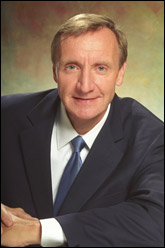The Nuclear Regulatory Commission recently asked the National Academy of Sciences to study cancer risk for people living near nuclear power plants and other nuclear facilities, and details of that research were discussed at yesterday’s meeting of the Academy’s Nuclear and Radiation Studies Board.
The research request came in response to “recurrent stakeholder concerns,” said Brian Sheron, director of NRC’s Office of Nuclear Regulatory Research.
The study will look at nuclear power plants as well as nuclear fuel facilities. It comes as the Obama administration is encouraging the expansion of commercial nuclear power.
The NRC currently relies on a 1991 study by the National Cancer Institute that found no link between nuclear plants and cancer. However, that study has been criticized for focusing on cancer deaths rather than cancer incidence. At the time the research was conducted, few states collected data on cancer incidence, which is why the NCI focused on mortality.
In addition, the earlier study looked at data on the county level — an approach that could obscure health problems occurring closer to nuclear facilities. Sheron noted that advances in geographic information systems will allow researchers to pinpoint more relevant populations for study.
Sheron said the research would occur in two phases. The first, set to be completed next summer, would review off-site radiation doses, evaluate cancer mortality and incidence data, pinpoint areas of study and determine how best to conduct the epidemiological research.
The second phase, which would begin immediately after the first and last two to three years, would analyze incidence of and deaths from radiation-related cancers near nuclear facilities. Both phases would conclude with a written report to the public.
At yesterday’s session to discuss the study, the NRSB heard from a number of stakeholders who urged that the research be carefully designed for maximum reliability.
They included a representative from the office of Congressman Ed Markey (D-Mass.), who has raised concerns about recent studies documenting health problems near operating nuclear reactors. Others who spoke included a representative from the office of U.S. Sen. James Inhofe (R-Okla.) — an advocate of the energy industry — and the industry’s own Nuclear Energy Institute.
Arjun Makhijani, president of the Institute for Energy and Environmental Research and a nuclear power critic, urged the NRSB to look at what besides nuclear facilities might be located in study areas, since industrial installations tend to be clustered in certain communities. He pointed out that this raises environmental justice concerns, since the communities where polluting facilities are located tend to be rural, poorer and have higher concentrations of minorities.
He specifically encouraged the NRSB to take a look at the Southern Company’s Plant Vogtle in Burke County, Ga. The plant is located near the Savannah River Site nuclear weapons facility, and concerns have already been raised about cancer in the surrounding area, where there is widespread radioactive pollution. The Southern Company has already secured $8.3 billion in taxpayer-backed federal loan guarantees to build two new reactors at the site, doubling its power output and thus increasing radioactive emissions.
Also addressing the NRSB was Dr. Steve Wing, an epidemiologist at the University of North Carolina at Chapel Hill whose own research documented a rise in cancers near the Three Mile Island nuclear plant in Pennsylvania following the 1979 partial meltdown.
“Knowledge about this topic can be most effectively advanced by studying childhood cancer incidence and in utero exposures,” he said. Developing fetuses are known to be especially sensitive to radiation, and focusing on children rather than adults will largely eliminate interference from occupational exposures.
Wing also pointed out that a number of epidemiological studies carried out near nuclear facilities in the U.S. and abroad found elevated cancer rates, but the authors dismissed the possibility that they were related to the nuclear plants because the radiation doses were assumed to be too low.
“The evidence produced was not believed,” Wing said. “Why conduct a study if the results cannot be interpreted as providing support for the hypothesis?”
The meeting closed with an opportunity for public comments, and the first person to speak was Sarah Sauer, who was diagnosed with a malignant brain tumor nine years earlier to the day at the age of 7. At the time her family was living in Minooka, Ill. near Exelon’s Dresden nuclear power plant. They had never considered the possibility that the plant could be connected to Sarah’s illness until learning about numerous other cancer-stricken children in the area.
They eventually discovered through records from the Illinois Department of Public Health that the infant mortality rate in surrounding Grundy County doubled from 1995 to 1999, while the rate of childhood cancers increased almost 400% during the same period. They also learned that the plant had leaked radioactive tritium into the environment — some of which had seeped into water supplies used by the Sauers and other area residents.
“I hope in this study you will remember who you are doing this for,” Sarah said.
(This story originally appeared at Facing South.)


